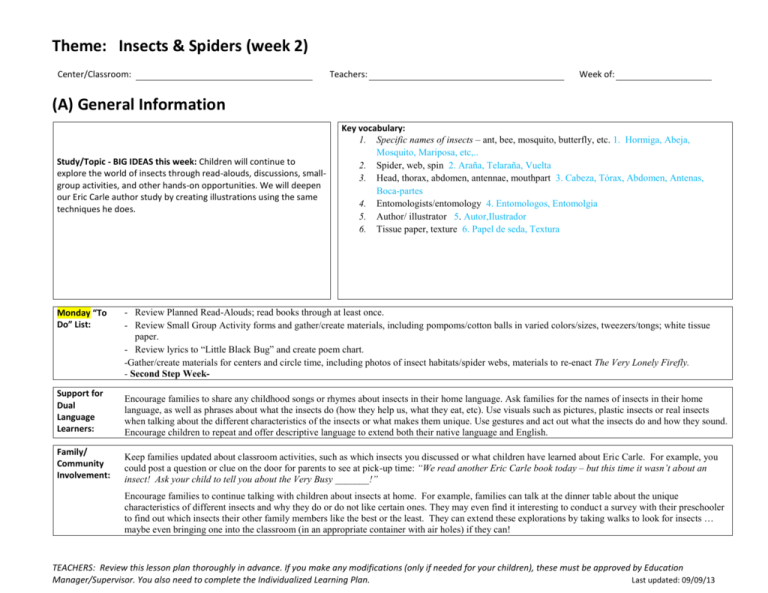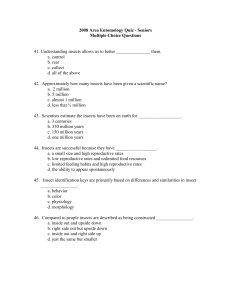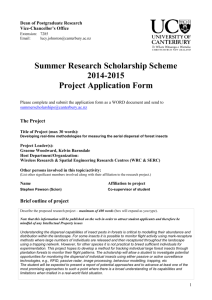
Theme: Insects & Spiders (week 2)
Center/Classroom:
Teachers:
Week of:
(A) General Information
Study/Topic - BIG IDEAS this week: Children will continue to
explore the world of insects through read-alouds, discussions, smallgroup activities, and other hands-on opportunities. We will deepen
our Eric Carle author study by creating illustrations using the same
techniques he does.
Monday “To
Do” List:
Key vocabulary:
1. Specific names of insects – ant, bee, mosquito, butterfly, etc. 1. Hormiga, Abeja,
Mosquito, Mariposa, etc,..
2. Spider, web, spin 2. Araña, Telaraña, Vuelta
3. Head, thorax, abdomen, antennae, mouthpart 3. Cabeza, Tórax, Abdomen, Antenas,
Boca-partes
4. Entomologists/entomology 4. Entomologos, Entomolgia
5. Author/ illustrator 5. Autor,Ilustrador
6. Tissue paper, texture 6. Papel de seda, Textura
- Review Planned Read-Alouds; read books through at least once.
- Review Small Group Activity forms and gather/create materials, including pompoms/cotton balls in varied colors/sizes, tweezers/tongs; white tissue
paper.
- Review lyrics to “Little Black Bug” and create poem chart.
-Gather/create materials for centers and circle time, including photos of insect habitats/spider webs, materials to re-enact The Very Lonely Firefly.
- Second Step Week-
Support for
Dual
Language
Learners:
Encourage families to share any childhood songs or rhymes about insects in their home language. Ask families for the names of insects in their home
language, as well as phrases about what the insects do (how they help us, what they eat, etc). Use visuals such as pictures, plastic insects or real insects
when talking about the different characteristics of the insects or what makes them unique. Use gestures and act out what the insects do and how they sound.
Encourage children to repeat and offer descriptive language to extend both their native language and English.
Family/
Community
Involvement:
Keep families updated about classroom activities, such as which insects you discussed or what children have learned about Eric Carle. For example, you
could post a question or clue on the door for parents to see at pick-up time: “We read another Eric Carle book today – but this time it wasn’t about an
insect! Ask your child to tell you about the Very Busy _______!”
Encourage families to continue talking with children about insects at home. For example, families can talk at the dinner table about the unique
characteristics of different insects and why they do or do not like certain ones. They may even find it interesting to conduct a survey with their preschooler
to find out which insects their other family members like the best or the least. They can extend these explorations by taking walks to look for insects …
maybe even bringing one into the classroom (in an appropriate container with air holes) if they can!
TEACHERS: Review this lesson plan thoroughly in advance. If you make any modifications (only if needed for your children), these must be approved by Education
Manager/Supervisor. You also need to complete the Individualized Learning Plan.
Last updated: 09/09/13
(B) Materials to Enhance Children’s Play
Blocks
Dramatic Play
Add:
Photos of insect habitats (beehives, ant hills, cocoons,
etc)
Photos of spider webs
Toys and Games
Keep: Materials from last week that children are
still engaged with.
Add:
Materials to re-enact The Very Lonely Firefly: e.g.,
flashlight, dog, cat, owl, and copy of book.
Art
Add:
Pictures of insects to sort or examine with
magnifying glass
Library/Writing
Add:
Tissue paper; paint; pieces of clean, unused carpet or
sponges to add different textures. See Eric Carle
Collage small-group activities.
Discovery/Science
Keep:
Read-aloud books for this week, last week; other
insect books or Eric Carle books
Eric Carle Author Study Poster
Props for retelling The Very Hungry Caterpillar
Sand and Water
Add:
Live insects (if possible) – in viewing tank or
containers with air holes
Clipboards & paper to record observations
Insect chart: children can sort pictures or plastic
figures by whether they are insects or not.
Music and Movement
Computers
Consider swapping instruments or movement
materials with another classroom to give students
exposure to unfamiliar items.
Outdoors
Cooking
Magnifying glasses – encourage children to look for insects, insect homes, etc.
If possible, take a nature walk to search for insects. Bring magnifying glasses, research journals, camera, etc.
Look carefully to decide if you have found an insect or an insect’s home.
(C) Group Experiences
Monday
Arrival
Tuesday
Wednesday
Thursday
Friday
Arrival: Attendance graph
Arrival: Attendance graph
Arrival: Attendance graph
Arrival: Attendance graph
Morning Circle:
Morning Circle:
Morning Circle:
Morning Circle:
© 2012 Acelero, Inc. All Rights Reserved. Uses are subject to the limitations set forth in your user agreement. Your right to use these materials is contingent upon remaining a current
SARGE subscriber with Acelero, Inc.
Monday
Tuesday
Wednesday
Thursday
Friday
Opening
Circle
Welcome song & one other
Welcome song & one other
Welcome song & one other
Welcome song & one other
SS Puppet Script
Movement
Review daily schedule and
rules now and throughout
the day
KWL: Revisit KWL chart
and talk with children about
what they have learned
about insects. (E.g., What
do insects have in common?
What do you know about
different insects? How do
ants help each other? What
do we get from bees? Etc.)
Is there anything else they
still want to learn?
QOTD: “Which insect do
you like the least?” (bees /
ants/ mosquitoes – or other
options children might
relate to) Provide visuals to
illustrate choices
Vote on which Eric Carle book
they enjoyed the most by
having them put a cube in front
of the book. Ask children to
estimate which got more votes;
then count cubes.
Relaxation
Transitions
Closing
Circle
Transition: QOTD: “Which
insect do you like the best?”
(cricket / butterfly/ firefly)
Provide visuals, e.g. from
Eric Carle books, to
illustrate choices. Have
children charting with
whiteboard/ pocket
chart/etc
Music/Movement: SS Song
& Poem: “Little Black
Bug”Little black bug,
Little black bug
Where have you been?
I've been under the rug,
Said little black bug.
Bug-ug-ug-ug.
Little green fly,
Little green fly,
Where have you been?
I've been way up high,
Said little green fly.
Bzzzzzzzzzzzzzzzzzz.
Review daily schedule and
rules now and throughout
the day
Review daily schedule and
rules now and throughout
the day
Transition:
Music/Movement: Choose
2
Transition:
Relaxation:
Music/Movement: Freeze
Dance (see below) & one
other
Transition:
Relaxation:
Transition: SS Brain
BuilderClosing Circle:
Goodbye song
Closing Circle:
Goodbye song
Review daily schedule and
rules now and throughout
the day
Transition: QOTD: “Have
you ever been stung or
bitten by an insect?”
(Yes/No) Respond
individually to children,
talking about what
happened, where, what it
felt like, etc.
Music/Movement: SS Song
& one other
Relaxation:
SS Skill Activity
Transition: SS Brain
BuilderClosing Circle:
Goodbye song
Relaxation:
Transition:
Closing Circle:
Review QOTD with the full
group, counting each
© 2012 Acelero, Inc. All Rights Reserved. Uses are subject to the limitations set forth in your user agreement. Your right to use these materials is contingent upon remaining a current
SARGE subscriber with Acelero, Inc.
Monday
Tuesday
Wednesday
Thursday
Friday
column and writing the
numeral; then discuss
results (what do you notice?
which answer has the most?
etc.).
Goodbye song
Group 1: The Very Busy
Spider by Eric Carle
ReadAlouds
Group 2: The Very Lonely
Firefly by Eric Carle
Group 1: Measuring Insects
SmallGroup
Activity
Group 2: Eric Carle
Collages, part 1
Special
Activities
Tangible
Acknowledgement System:
Group 1: The Very Lonely
Firefly by Eric Carle
Group 2: The Very Busy
Spider by Eric Carle
Group 1: SS BookGroup 2: Actual Size by
Steve Jenkins
(recall from “Growing”
unit; point out the
heaviest/longest insect)
Group 1: Actual Size by
Steve Jenkins
(recall from “Growing”
unit; point out the
heaviest/longest insect)
Group 2: SS Book-
Group 1: Eric Carle
Collages, part 1
Group 1: SS Skill Practice
Activity-
Group 1: Eric Carle
Collages, part 2
Group 2: Measuring Insects
Group 2: Eric Carle
Collages, part 2
Group 2: : SS Skill Practice
Activity-
Working Like Ants: In
advance, hide food around
the room (e.g., plastic food
from Dramatic Play area, or
use pictures). Have children
try to find it and collect it in
a basket for the “queen
ant.” Point out how fast
children were able to do
this, working together – and
how much longer it would
take to collect all of that
food by yourself. Talk
Insect Mouths: Using a
straw and needle, illustrate
the different types of
“mouthparts” that insects
have. Some insects have a
mouthpiece that helps them
suck nectar; some have a
mouthpiece that is sharp
and pointy to pierce skin;
and some have a mouthpart
to bite/chew. Show pictures
or models of several
different insects and ask if
Play music for children to
dance to. When the music
stops, hold up a shape and
have children “freeze” in
that shape – working
together if possible.
Pompom Patterns *see
activity guide ( during
free choice time)
© 2012 Acelero, Inc. All Rights Reserved. Uses are subject to the limitations set forth in your user agreement. Your right to use these materials is contingent upon remaining a current
SARGE subscriber with Acelero, Inc.
Monday
Tuesday
Wednesday
Thursday
about how ants work
together.
Outside
Friday
children know which
bite/sting vs. which do not.
Inclement Weather Plan:
Individual Child Planning Form
School Readiness Goal
Focus Domain(s)
Physical
Approaches to
Learning
Language &
Literacy
Cogn./ Gen.
Knowledge
Name
Soc-Emotional
Focus
Date
Child’s
Week of:
Strategy/Activity
Focus TS
GOLD
Objective(s)
Why Chosen?
(IFSP, TS Gold Report,
family input, conference
goal, etc.)
NOTE: Children with similar needs may benefit from
differentiated instruction (e.g. during small-group activity).
You can use the “Small Group” column at right to make notes
about possible groupings.
Example: 1. Routine – activity, state how you are
individualizing for this child.
CHECK when
implemented
Teachers:
Possible small-group?
Center/Classroom:
1.
Tuesday
2.
3.
1.
Tuesday
2.
3.
1.
2.
© 2012 Acelero, Inc. All Rights Reserved. Uses are subject to the limitations set forth in your user agreement. Your right to use these materials is contingent upon remaining a current
SARGE subscriber with Acelero, Inc.
3.
1.
2.
3.
1.
2.
3.
1.
2.
3.
1.
2.
3.
IFSP Child Planning
Child’s Name
IFSP Goals
Classroom Plan: What’s the Activity/Who’s Supporting the Child
© 2012 Acelero, Inc. All Rights Reserved. Uses are subject to the limitations set forth in your user agreement. Your right to use these materials is contingent upon remaining a current
SARGE subscriber with Acelero, Inc.
*Please review all IFSP plans including Speech Only to ensure implementation of all classroom goals.
*For speech goals the what/who would be: Directed by the Speech Language Therapist
© 2012 Acelero, Inc. All Rights Reserved. Uses are subject to the limitations set forth in your user agreement. Your right to use these materials is contingent upon remaining a current
SARGE subscriber with Acelero, Inc.







